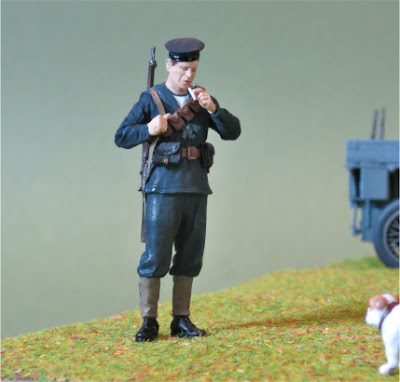I had this Roden 1:32 kit of a R.N.A.S. Sopwith Triplane on my to do list for a long while, and as part of my series of planes associated with certain pilots, I wanted to finish it as one of the two Triplanes flown by Raymond Collishaw both named 'Black Maria'. This type is unusually tall in relation to its width and length, so in order to fill out the necessary larger display case, I decided to make a scene of it and add in a kit I had available of a R.N.A.S. Rolls-Royce Armoured Car (also a Roden kit).
In addition, to add a human element I included a figure of a rating from the Naval Division which was sent into Flanders in 1914 and involved in the defence of Antwerp. No actual pilot? Well, there is now a figure of Collishaw available, but to get it you have to buy the Wingnuts Wings kit of the Sopwith Triplane. There are also a few figures on the market of R.N.A.S. officers which would have just about looked the part, but they weren't around back then. And I don't have any other kit with as much potential as a setting for this figure, which turned out to be very enjoyable to put together and then paint. To be honest, it's out of scale despite being advertised as 1:32. It's by Tommy's War and it's really a '54mm' figure which is supposed to be equivalent to 1:32 but I measured it and this guy would have to be 6ft 3 or 4 in height. Not impossible; as you can see I deliberately placed him near the front.
I'm happy to gloss over the various trials and tribulations endured with the two main kits. Though it might not seem so outwardly, for me a lot of the fun comes out of problem solving: how to make things fit; researching details and markings (eg. the decals for this particular plane were sourced from Pheon, a specialist company); questioning historical accuracy; even simply trying to interpret ambiguous instructions. There are often new techniques to employ. The most time consuming example of that with this project was putting together those wire wheels - definitely worth it, they have a classic vintage look. There wasn't an excessive amount of rigging (unlike that flying boat project before Christmas!) but what with the unusual wing layout it was distinctly weird. On top of the modelling challenges, there is a factor I never had to face as a kid when buying cheap Airfix kits in plastic bags - the demand for accurate detail in today's more mature modelling market means that one is often building and fitting components and then hiding them inside forever unseen. See here the two engines, barely visible in the Triplane, completely invisible inside the Rolls-Royce.
The triplane construction grew out of a desire for greater manoeuvrability - conferred by the shorter wings and large wing area - and pilot visibility, arising from the narrow chord wings and the centre wing being at head height. At the time, there weren't the engines available to enable going the alternative route of speed + power + armament. The Sopwith Triplane turned out to be highly agile and climbed "like a homesick angel". And yet the R.F.C. cancelled their order, in favour of the promising SPAD VII, leaving the Navy as the sole British operators (the French formed a squadron as well). The Navy and its pilots tended to be overshadowed by the RFC, which is why the Triplane isn't so well known, nor is Ray Collishaw, even though he was the 3rd most successful British and Commonwealth airman, with 60 victories - 18 of them with this particular plane, N5492. The three flights of his squadron, Naval 10, were prodigiously effective, especially Collishaw's own 'Black Flight' - so called from their black painted noses; flights were commonly colour coded - which included Black Roger, Black Death, Black Sheep and Black Prince as well as Collishaw's own Black Maria, all flown by Canadians like Collishaw himself.
This type made a big impression on the Germans when shortage of planes at the Front forced the R.N.A.S. to provide some of their squadrons, originally intended for use in defence of naval bases on the Channel. The Triplanes and their aggressive pilots were very successful against the Albatrosses and others they confronted, and the Germans were soon avoiding the three winged machines. This led to a major effort by many German firms to produce their own triplanes, largely completely wasteful, since only one came into operational use, the Fokker Dr.I, famously flown by Manfred von Richthofen. But triplanes had had their time in the sun. The Sopwith plane was already out of service by the time the Fokker Triplane appeared, replaced by the even better Sopwith Camel. It wasn't happy with the two gun armament which was becoming standard, and its unusual construction entailed far too much time spent in repair shops. And speed was progressively becoming more important than agility.







Very, very impressive Marj!
ReplyDeleteThanks Graham! It's a weird one, with the mixture of scales (1:35, 1:32, '54mm') and dates (1914, 1917), but for me somehow it works, thanks to its theme ie. the R.N.A.S. There were several satisfying moments while putting it together - the engines, the wire wheels, the cigarette, the rigging, etc.
Delete